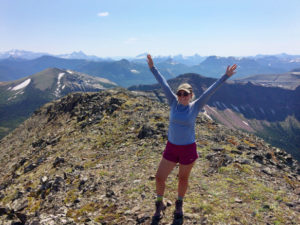 After a cold and wet six-mile hike, there was nothing I wanted to do more than crawl into my sleeping bag and go to sleep. However, everyone still needed to eat. Of course that day my course job was to help cook dinner.
After a cold and wet six-mile hike, there was nothing I wanted to do more than crawl into my sleeping bag and go to sleep. However, everyone still needed to eat. Of course that day my course job was to help cook dinner.
At home, I am more of a microwave chef. If all else fails I will just go to Wawa, a Pennsylvania gas station convenience store, and grab a hoagie. That being said, cooking is obviously not my strong suit. Luckily, on a WRFI course, there are two cooks each night so I wasn’t alone in my efforts. As I started chopping the bell peppers for Jambalaya, and the other cook started the stoves, I looked at the rain falling onto Bovin Lake and pondered what we learned in class that day.
An excerpt from the book, The Carnivore Way, by Cristina Eisenberg, explained the importance corridors have for large predators and how corridors are implemented in the environment. A corridor is a landscape that species move through to get to other habitats. For example, the goal of the Yellowstone to Yukon Initiative, or Y2Y, is to connect core habitats that allow animals to move from one area to another. As I continued cooking dinner, I thought more specifically how the area we are in, The Castle Wildland Provincial Park, may act as a corridor.
The Castle was officially designated as a provincial park three years ago in 2015. The park had a three million dollar budget to implement a plan and add new features. The park’s management plan protects the wildlife and headwater region, respects and upholds the rights of Aboriginals in the park, and ensures recreational opportunities for the public. ATVs and other motorized vehicles were outlawed. Snowmobiles are still allowed and research is being done to assess their impact.
While making sure the rice didn’t burn and my hands didn’t freeze, I thought about the grizzly bears this corridor is important to. Grizzly bears need corridors to live and procreate successfully. Grizzly bears have a very low reproductive rate. Once cubs are born and reach maturity, the female cubs are philopatric, meaning they stay in their mother’s home range. However, male grizzly bears need 400- 1,000 square miles to roam during their lifetime to eat, hibernate, and, most importantly, to mate. Without the dispersal of male grizzlies, some populations of grizzlies could become isolated and prone to inbreeding.
Cooking dinner made me think of what the grizzlies might be eating out in the Castle. Grizzlies are omnivores, like humans, and munch on a variety of plants, animals, and nuts. Having to consume a lot of calories daily, grizzlies have been known to eat over 200 different species. Grizzlies are opportunistic hunters and often scavenge wolf kills for an easy meal, despite 80% of their diet being plants. Without the Castle acting as a corridor for grizzlies, they might travel across roads and face devastating automobiles, venture into towns to find food, and struggle for survival. With the corridors in place, grizzlies can avoid roads and humans, forage for food, and have a better chance at survival.
As the meal began to come together, the other cook and I called everyone to climb out of their tents and their warm sleeping bag cocoons to gather under our rain tarp for dinner. We took a moment of silence before our meal as we do every night and in that moment I felt very lucky to be in such an amazing place for people and bears alike. In the end, the Jambalaya was a success and nobody was harmed in the process.